Don’t miss what’s next in
hereditary angioedema (HAE)
HAE is a rare, unpredictable disease that can be life‑threatening

During an attack, people with HAE may experience many complications


face
- Problems speaking clearly
- Poor vision from swollen face causing eyes to close
- Swells may cause fear and shame
Throat/AIRWAY
- Shortness of breath
- Difficulty speaking
- Choking and fear of death from being unable to breathe
- Highest emotional impact compared to other attack locations
- Hospitalization more likely to occur

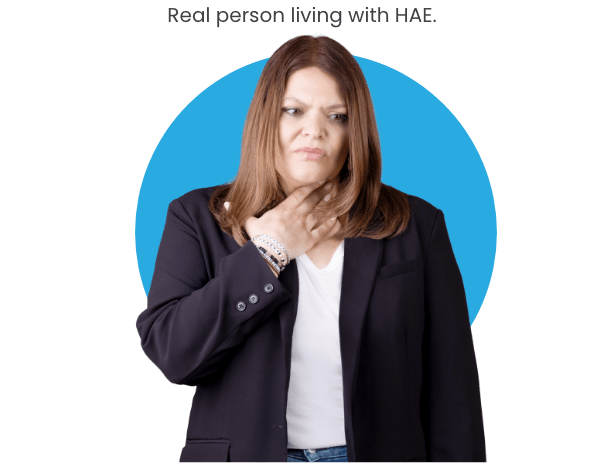

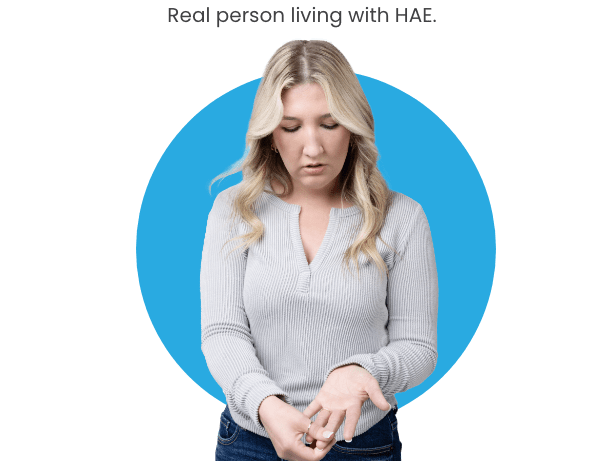
Hands & Arms
- Lack of ability to hold objects (phone, pen, glass/cup)
- Difficulty texting or typing
- May make it difficult to give oneself an injectable or IV HAE medication
- Embarrassment being seen in public
Stomach
- Mild to severe stomach pain with nausea, vomiting, and/or diarrhea
- Abdominal pain can restrict ability to move


Genitals
- More-frequent attacks during periods, giving birth through C-section, and breastfeeding
- Estrogen-containing birth control pills can trigger HAE attacks
- Potential attacks during childbirth
Legs & Feet
- Difficulty walking or running
- Cannot fit into shoes
With never knowing when, where, why, and how HAE will present itself, there comes naturally a lot of anxiety.
— Jamie, real person living with HAE

Swelling in HAE is a result of EXCESS BRADYKININ PRODUCTION
Bradykinin is a natural substance found in the body that plays a role in inflammation and swelling
Slide to see what blocking the effects of bradykinin can do to help people with HAE.


Most people with HAE have a genetic disorder that causes them to produce too much bradykinin, resulting in swelling throughout the body
Blocking excess bradykinin can help prevent, shorten, or stop HAE swells
HAE attacks may last for days if not treated
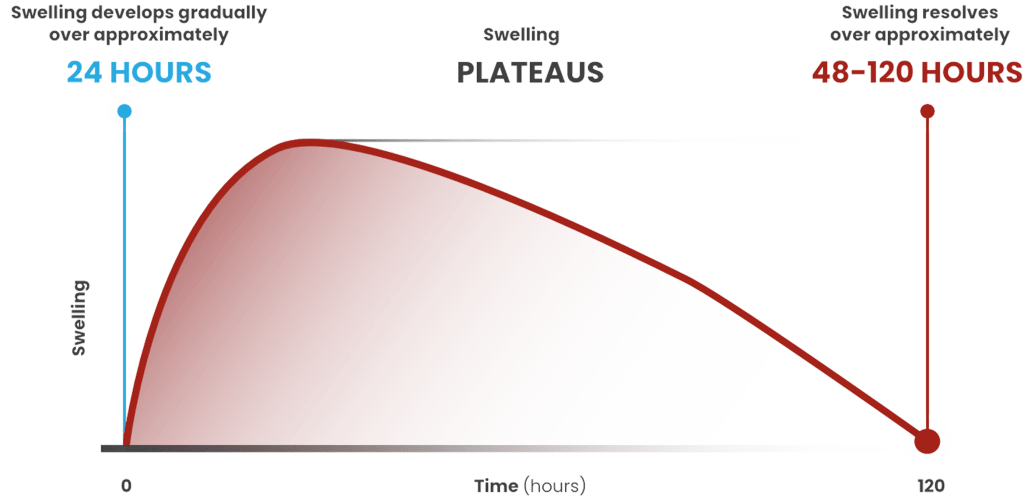
Tap the chart to learn more
Swelling develops gradually
over approximately
Swelling develops gradually
over approximately
Swelling resolves over
approximately
24 HOURS
PLATEAUS
48-120 HOURS
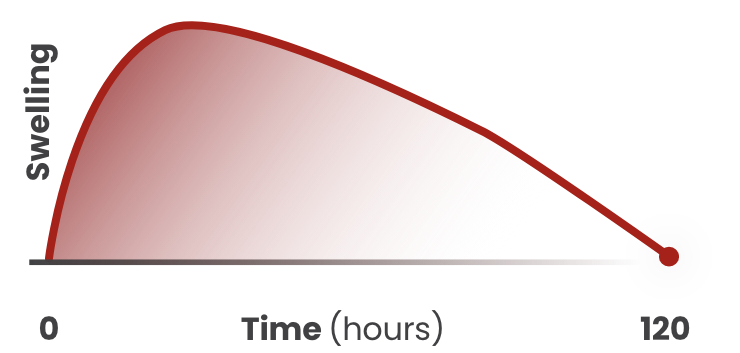
GET THE FACTS
HAE generally runs in families. If you have a relative with HAE, you are more likely to have it, too. Both men and women have HAE equally
Estrogen levels can affect both the frequency and severity of attacks. Since women have more estrogen in their bodies, HAE can be worse for them
HAE attacks that only affected the face were linked to more missed work days (26.5%) and worse productivity (48.2%) than attacks affecting other parts of the body
In a 2017 survey of 445 people with HAE in the United States, 35.3% reported feeling anxiety and 20.9% reported feeling depression
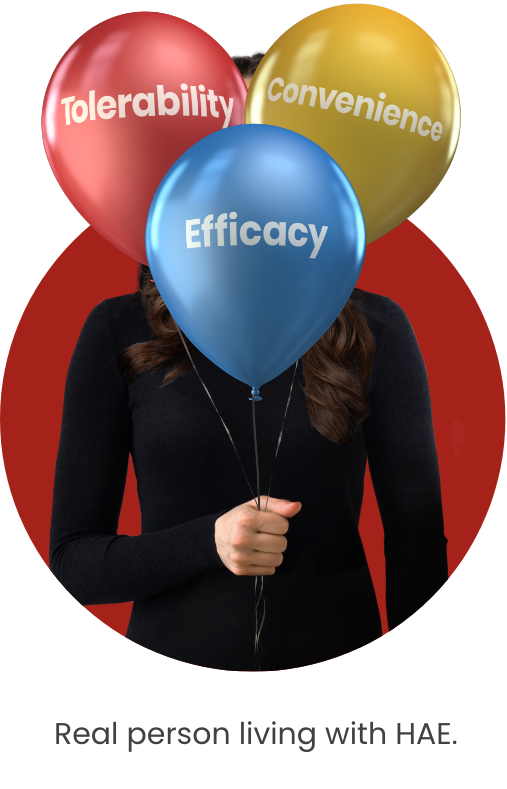
Burden of HAE Management

Living with HAE
References
- Abdulkarim A, et al. Hereditary angioedema. In: StatPearls [Internet]. Treasure Island (FL): StatPearls Publishing; 2023. https://www.ncbi.nlm.nih.gov/books/NBK482266/
- Anderson J, et al. Allergy Asthma Clin Immunol. 2021;17(1):60.
- Angioedema Centers of Reference and Excellence. Who we are. Accessed May 23, 2024. https://acare-network.com
- Aygören-Pürsün E, et al. Allergy. 2013;68(8):1034-1039.
- Aygören-Pürsün E, et al. Orphanet J Rare Dis. 2014;9(99):1-9.
- Azmy V, et al. Allergy Asthma Proc. 2020;41(Suppl 1):S18-S21.
- Banerji A, et al. Allergy Asthma Proc. 2015;36:213-217.
- Banerji A, et al. Ann Allergy Asthma Immunol. 2020;124:600-607.
- Betschel SD, et al. J Allergy Clin Immunol Pract. 2023;11(8):2315-2325.
- Betschel SD, et al. Allergy Asthma Clin Immunol. 2024;20(43):1-8.
- Betschel SD, et al. Allergy Asthma Clin Immunol. 2025;21(25):1-11.
- Broderick L, et al. Orphanet J Rare Dis. 2025;20(16):1-11.
- Busse PJ, et al. N Engl J Med. 2020;382:1136-1148.
- Busse PJ, et al. J Allergy Clin Immunol Pract. 2021;9(1):132-150.
- Castaldo AJ, et al. Ann Allergy Asthma Immunol. 2025 May 23:S1081-1206(25)00258-3.
- Chong-Neto HJ. World Allergy Organ J. 2023;16(3):100758.
- Covella B, et al. Future Pharmacol. 2024;4(1):41-53.
- Data on file, Pharvaris.
- Everyday Health. Speaking hereditary angioedema (HAE): a glossary of terms used to describe symptoms, tests, treatments, and more. Accessed May 23, 2025. https://www.everydayhealth.com/hereditary-angioedema/glossary-of-terms-used-to-describe-symptoms-tests-treatments-and-more/
- Farkas H, et al. Clin Transl Allergy. 2021;11(4):e12035.
- Ferreira G, et al. J Investig Allergol Clin Immunol. 2023;33(5):332-362.
- Firazyr [prescribing information]. Shire Human Genetic Therapies, Inc. Accessed June 6, 2025. https://www.accessdata.fda.gov/drugsatfda_docs/label/2024/022150s016lbl.pdf
- Food and Drug Administration. The voice of the patient – hereditary angioedema. Published May 2018. Accessed May 23, 2025. https://www.fda.gov/files/about%20fda/published/The-Voice-of-the-Patient—Hereditary-Angioedema.pdf
- Geba D, et al. J Drug Assess. 2021;10(1):51-56.
- Gülbahar O. Balkan Med J. 2021;38(2):73-81.
- Haegarda [prescribing information]. CSL Behring GmbH. Accessed June 6, 2025. https://www.fda.gov/media/105611/download
- Hereditary Angioedema Canada. Learning to live with hereditary angioedema. Accessed May 23, 2025. https://haecanada.org/wp-content/uploads/sites/64/2020/10/HAE-Canada-patient-booklet-Updated-2020-v2.pdf
- Hereditary Angioedema International. About HAEi. Accessed May 23, 2025. https://haei.org/about-haei/
- Hereditary Angioedema International. Frequently asked questions. Accessed May 23, 2025. https://haei.org/hae/faq/
- Hsu FL, et al. Allergy Asthma Clin Immunol. 2022;18(64):1-9.
- Jean-Baptiste M, et al. Orphanet J Rare Dis. 2022;17(232):1-12.
- Johnston DT, et al. Allergy Asthma Proc. 2020;41:S43-S46.
- Leibovich-Nassi I, et al. Clin Rev Allergy Immunol. 2021;61:15-28.
- Lima H, et al. Front Allergy. 2023;10(4):1-5.
- Lo SH, et al. Pharmacoecon Open. 2022;6(2):231-239.
- Longhurst HJ, et al. Br J Hosp Med (Lond). 2019;80(7):391-398.
- Lumry WR, et al. Allergy Asthma Proc. 2020;41(Suppl 1):S08-S13.
- Manning ME. Allergy Asthma Proc. 2020;41(Suppl 1):S22-S25.
- Maurer M, et al. Allergy. 2022;77(7):1961-1990.
- Mayo Clinic. Hives and angioedema. Accessed May 23, 2025. https://www.mayoclinic.org/diseases-conditions/hives-and-angioedema/symptoms-causes/syc-20354908
- National Organization for Rare Disorders. Hereditary angioedema. Accessed May 23, 2025. https://rarediseases.org/rare-diseases/hereditary-angioedema/
- Pagnier A, et al. Pediatr Allergy Immunol. 2024;35:e14268.
- Purdue University. College of Science. Career development. Accessed May 23, 2025. https://www.purdue.edu/science/careers/what_can_i_do_with_a_major/Career%20Pages/immunologist.html#:~:text=Immunologists%20are%20research%20scientist
- Radojicic C, et al. Allergy Asthma Proc. 2021;42(3):S4-S10.
- Riedl MA, et al. Ann Allergy Asthma Immunol. 2017;119(1):59-64.
- Riedl MA, et al. Allergy. 2020;75(11):2879-2887.
- Riedl MA, et al. Allergy Asthma Proc. 2021;42:S17-S25.
- Savarese L, et al. Allergy Asthma Proc. 2021;42(1):e1-e7.
- Shamanaev A, et al. Front Physiol. 2023;14:1146834:1-13.
- Smith TD, et al. Ann Allergy Asthma Immunol. 2024;133:380-390.
- Soteres DF, et al. Clin Case Rep. 2021;9(11):e05086.
- Takhzyro [prescribing information]. Dyax Corp. Accessed June 6, 2025. https://www.accessdata.fda.gov/drugsatfda_docs/label/2023/761090s010lbl.pdf
- US Hereditary Angioedema Association. Conquering hereditary angioedema together. Accessed May 23, 2025. https://www.haea.org/
- US Hereditary Angioedema Association. About hereditary angioedema. Accessed May 23, 2025. https://www.haea.org/pages/p/what_is_hae#:~:text=Symptoms%3A%20HAE%20Attacks,those%20in%20the%20same%20family%204
- US Hereditary Angioedema Association. Treatments. Accessed May 23, 2025. https://www.haea.org/pages/p/treatments
- Wedner HJ, et al. J Allergy Clin Immunol Pract. 2021;9(6):2305-2314.e4.
- Zacek L. Nursing. 2022;52(12):44-50.
- Zanichelli A, et al. Ann Allergy Asthma Immunol. 2016;117:394-398.
- Zuraw BL. World Allergy Organ J. 2010;11:S25-S28.
- Zuraw BL, et al. Allergy Asthma Proc. 2025;46:209-217.




